Ponsonby Baptist Church
John Avery 1779 (1/8 mechanical)
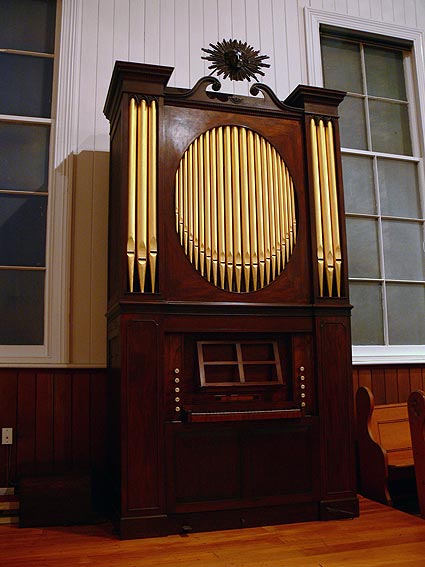
Photo JRM
Sited on a ridge, high above the harbour, Ponsonby Baptist Church was constructed in 1886 in timber in a Classical idiom, with applied pilasters, quoining and eaves brackets. The building has been carefully restored very recently and the woodwork repainted in heritage colours.
The 1779 organ built by Johannes [John] Avery, of London, is the oldest in Australasia that remains in a form close to the original. Its initial origins are unknown, the fine detail of its casework suggesting a stately home. It was selected by Dr George Elvey, of St George's Chapel, Windsor and refurbished in 1859 by Bishop, Starr & Richardson, of London, an internal inscription stating “this organ was repaired by John Smith for Bishop, Starr and Richardson, Lisson Grove, London, Novr 1859”. If this were the Bristol John Smith, then the organ may well have come from the West Country. It was sent to Auckland, where it was initially used in St Paul's Church and acquired by Ponsonby Baptist Church in 1898 from a tailor's shop, so clearly may have been in private ownership for some years.
In 1909 it was rebuilt by W.F. Willmette, organbuilder of Auckland, who possibly removed the original Sesquialtera and Cornet and replaced it by a Flute 4ft. A further rebuilding took place in 1964 by Ralph Sewell, of Auckland who may have replaced damaged Avery pipework in zinc. By the end of the 1990s the organ was a sad travesty of the original, with numerous alterations including a pedal board and pedal Bourdon. However, there was the potential for a comprehensive restoration, which was carried out in 2004-2005 by Goetze & Gwynne, of Welbeck, England in association with consultant John Maidment.
The restoration work included the following:
Reconstruction of the original diagonal ribbed bellows and feeder, with associated foot or hand blowing - specially constructed levers were provided to actuate the feeder. An external Ventus electric blower was also installed and a brass wind telltale fitted to the right hand stop jamb operating off the original pulley.
Full restoration of the slider windchest, having survived largely unaltered. Later veneers on the upperboards were removed to permit the reconstruction of the original stop list. The pallets were releathered with a double layer of sheepskin and some joints were sealed with animal glue and sheepskin. A new brass pull down plate was fitted. New rack boards were made for the Principal and Sesquialtera/Cornet. The Twelfth, Fifteenth, Dulciana and Sesquialtera / Cornet are placed on a raised shifting movement board operated by a new foot-operated iron lever.
The key action incorporates stickers that are mostly original, together with the original roller board. The stop action is mostly original, although the position had been changed at various periods. It incorporates iron levers, actuated by the drawstop rods, operating on the sliders.
The mahogany casework, of very high quality, required much restoration owing to the alteration or removal of many components. The upper rear panels, together with the console fall panel, have been remade, holes for electrical fittings have been filled, and a new console roof and music desk provided, closely matched to Avery patterns. The original patination has been carefully preserved and the new timber sections integrate perfectly.
The keyboard naturals were recovered in bone, with scored platings, and are a close match with the 1776 Avery keys at Buckfastleigh, Devon.
The pipework required major restoration or reconstruction given the removal of much original material. The Stopped Diapason is new, except for the surviving GG pipe, the scale of the larger rear pipes determined from markings on the original upperboard and the remainder from the 1776 Buckfastleigh organ (the original Avery stop had been removed). The Principal, Twelfth, Fifteenth and Sesquialtera/Cornet are substantially new, but incorporate some older pipes. The Open Diapason, the bass of which is in the façade, together with the Dulciana, is entirely original. The Hautboy has been reconstructed following the discovery of a spare treble slide at the rear of the organ, and other evidence; the pipes are based upon the 1790 Robert & William Gray chamber organ at Burghley House, Lincolnshire, and the nag's head swell box on the dismantled 1786 John England organ at Petworth House, Sussex. It is operated by an iron pedal to the right of the blowing pedal.
The wind pressure is 63mm, somewhat high for instruments of the period and the pitch set to A=415 at 18º Celsius. The tuning is based upon a 1/5th comma meantone tuning as used by J.C. Bishop for his 1829 organ at St James', Bermondsey but modified by Martin Goetze to improve the important natural keys.
The instrument is highly significant for the following reasons:
• It is the largest known example of Avery's work to remain in recognisable form
• Avery built few new organs and only a small proportion survive
• Avery's work was highly esteemed at the time of construction
• It is the oldest organ in Australasia where the maker's name and provenance can be readily established
• It is one of only 10 Avery organs that can be identified worldwide: all are chamber organs
• It has a very complete tonal range for the period including GG compass, divided Sesquialtera / Cornet and 'swelling' Hautboy
• It has a delightful mahogany case capped by swan's neck pediment, apollo mask with sunburst motif, Gothicke arches over side flats and carved friezes
• The case design follows typical 18th century forms, with the oval shaped central flat
• The provision of a speaking façade at eight-foot pitch is unusual for a small organ
• The surviving components have been carefully restored and the new materials closely replicate Avery's practices elsewhere
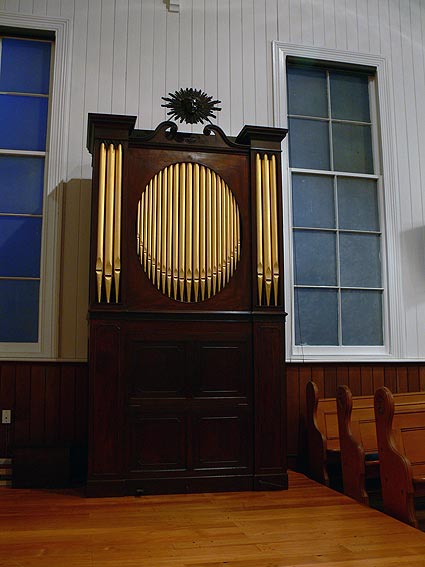
Photo JRM
John Avery 1779 (1/8 mechanical)
| BASS JAMB Cornet Treble Sesquialt Bass Dulciana Twelfth StDiapason Bass |
[12.15.17] [17.19.22] [8] [2-2/3] [8] |
TREBLE JAMB Hautboy Fifteenth Principal OpDiapason StDiapason Treble |
[8] [2] [4] [8] [8] |
Compass: GG, C, AA. D-e3
Lever swell pedal for Hautboy
Shifting movement for upperwork
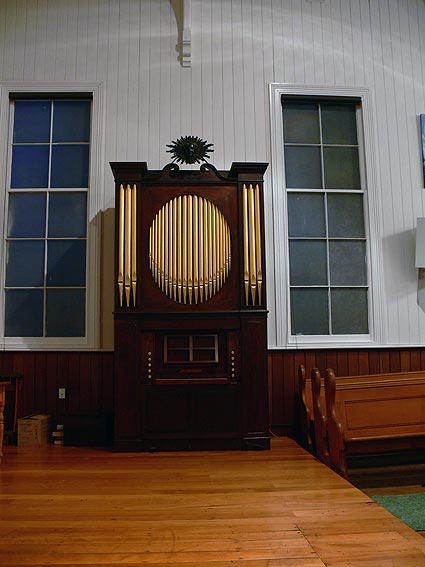 |
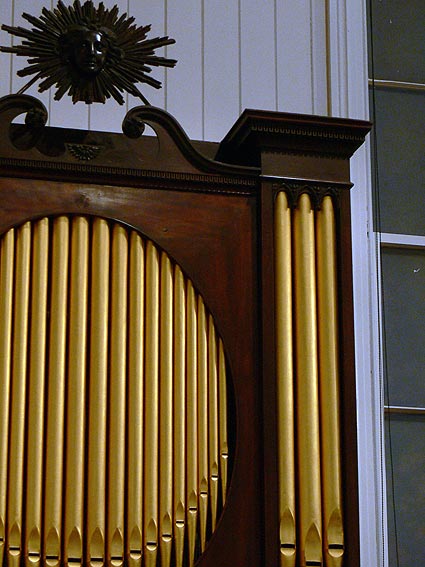 |
|
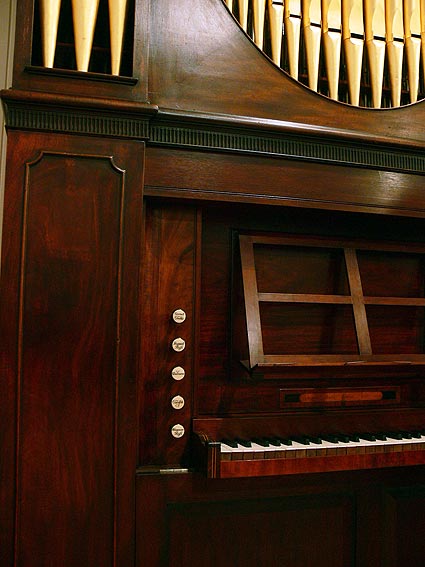 |
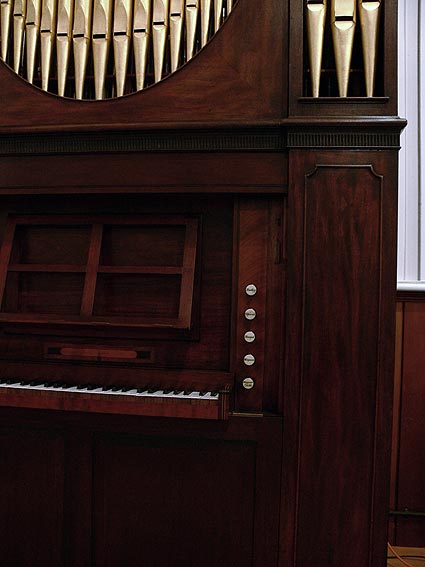 |
Photos JRM
Notes prepared by John Maidment
The research into John Avery published by Paul Tindall in BIOS Reporter vol.xxvii, no 4 (October 2003) pp.16-20 and vol.xxvii, no 1 (January 2004) pp.19-25 is gratefully acknowledged.